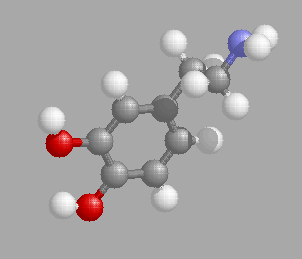

http://www.ghcc.msfc.nasa.gov/corredor/corredor_galleryH.html
The Gene
The gene of interest in treating procrastination is the gene encoding for the dopamine D2 receptor, which is one of five types of receptors for dopamine. It is an integral member protein that is hypothesized to be involved in psychiatric disorders, especially schizophrenia, and linked to a susceptibility to alcoholism. Defects in the gene for the dopamine D2 receptor are also linked to myoclonus dystonia, a movement disorder. This protein contains 443 amino acids and has a gene map locus of 11q23 in humans.
Dopamine Structure

http://ep.llnl.gov/msds/DeAnza/
The Scientific Paper view article
This scientific article states that humans, as well as monkeys, tend to work harder and more efficiently when there is a reward for their efforts. In order to receive those rewards, monkeys and humans have the ability to become skilled at exploiting visual cues to learn how much work remains before a reward will be given. A group of researchers from the Department of Health and Humans Services, the National Institute of Health, and the University of Massachusetts Medical School examined the "role of dopamine D2 receptor in rhinal cortex" in the visual learning process. The monkeys had to perform a trial of releasing a lever when the color of a dot on the cue changed. A drop of liquid was given to the monkey if the trial was completed successfully. After the introduction of a reward schedule, monkeys correlated their number of errors to the number of trials left before they were supposed to receive their reward. The removal of the bilateral rhinal cortex from the brain inhibited this type of visual learning from proceeding. The scientists then injected DNA designed to hinder the production of functional dopamine D2 receptors into the monkey rhinal cortex of the brain, which resulted in a reduction of D2 receptor ligand binding. If the ligand is not able to bind to the receptor, the effects of the ligand are not experienced. This lack of gene expression generated an inability o associate the visual cues with the remaining work before he reward, the same visual learning deficiencies detected after the surgical removal of the rhinal cortex. The main difference in these two methods was that the monkeys were able to recover from the DNA injection within a few weeks of the treatment and the surgical effects on the monkeys were irreversible.
The researchers cautioned that other possible methods for achieving the same results may cause mechanical tissue damage, but also mentioned that, since this approach had not previously been used, it would be beneficial to compare these results with those from other classical experiments focusing on the same receptor. A conclusion was made that the interference of the function of the dopamine D2 receptor in the rhinal cortex of a monkey leads to a lack of correlation between the visual cues and the amount of work before a reward is given.
Popular Press Paper view article
This popular press article explains that the dopamine receptor is important in learning to recognize the correlation between working and receiving a reward for that work. The article refers to the US National Institute of Mental Health and their finding that the suppression of the dopamine receptor causes monkeys to not relate their work with the resulting reward. The monkeys "normally" do not work as hard when the reward is in the distance, but tend to work harder as the reward gets nearer. When their dopamine receptor was inhibited, these monkeys were not able to use the provided visual clues to determine when the reward would be provided, so they worked harder throughout the trial and made fewer errors.
The aforementioned conclusions were from an experiment done by the NIMH Laboratory of Neuropsychology where the rhinal cortex area of the monkey's brain was injected with a DNA antisense agent, terminating the production of the targeted proteins. The experimental monkeys had already been trained to complete a trial or releasing a lever when the color on a monitor changed. There was also a bar on the monitor measured their progress and indicated when they would receive the reward. After the DNA antisense injection, the monkeys were no longer able to associate the visual cue of progress with how much work remained before the reward. The researchers also concluded that the experimental monkeys were considered workaholics as suggested by their lack of recognition for the distance of the reward.
Critique
The popular press article, "Gene Tweak Ends Procrastination", leads readers to believe that this cure for procrastination is available, or soon to be available, for humans. The article clearly states that the experiments have only been performed on monkeys, but it leaves open the possibility that this cure will work for humans "just in time for back-to-school season". Even if some day procrastination in humans will be able to be cured, it is highly unlikely that it will be anytime soon or that it will be achieved by this method. It is not plausible, nor feasible, to inject all humans who suffer from procrastination with a DNA antisense agent every few weeks.
The scientific article, "DNA targeting of rhinal cortex D2 receptor protein reversible blocks learning of cues that predict reward", does not mention the possibility of this procrastination cure in relation to humans. It strictly states that this gene suppression enables monkeys to equate visual clues with a reward. The researchers of the scientific article are still seeking to discover which other cognitive behaviors, if any, rely on the same area of the brain as focused on by their experiment, the rhinal cortex. Their focus for future experiments does not lie in curing humans of procrastination, but in using the recombinant DNA approach to investigate the functions of other components affecting cognitive behavior.
Both the scientific article and the popular press article describe the basis of the experiments at hand, but there is a vast difference in the terminology and language used in the scientific article as opposed to the popular press article. The popular press article targets readers who are not scientists and therefore uses language to describe the experiment that is consistent with an average person's vocabulary. This article also does not go into very much detail about the experiment, but only gives a brief account of the methods, which is acceptable because the average person reading this article is not interested in the methods of the experiment, but in the conclusions drawn from the experiment. The average person doesn't need, or want, all of the statistics; they just want to hear and believe any conclusions they can relate to. The scientific article, however, is targeted towards other scientists who are expected to understand basic scientific procedures and vocabulary. This language provides that details of the methods and materials, results, and discussion that the popular press article doesn't address. It would not be appropriate or acceptable for this article to leave out important steps and details of the experimental method, as the scientists reading this article are looking for the facts and details associated with the experiment. The scientists need these statistics and other data in order to believe and trust the conclusions. Although in different manners, each article does a good job of explaining the complicated experiment in a manner that the targeted audience is able to comprehend.
It is interesting that although the popular press article mentioned the NIMH as the researchers for this experiment, it failed to mention the other groups involved in the experiment. It also did not refer to the scientific paper in which the results and conclusions of the experiment were published. The scientific paper was sure to mention each person and organization involved in the experiment in order to give them credit for their work.
References:
"Gene Tweak Ends Procrastination: Lacking Brain receptor, slacking monkeys become workaholics" 2004 Aug 12. Better Humans. <http://www.betterhumans.com/News/news.aspx?articleID=2004-08-12-1> Accessed 2004 Sep 11.
Liu Z., et al. 2004 Aug 9. "DNA targeting of rhinal cortex D2 receptor protein reversible blocks learning of cues that predict reward." PNAS Online vol. 101 no. 33 (2004). <http://www.pnas.org/cgi/content/full/101/33/12336?hits=10&FIRSTINDEX=0&FULLTEXT=rhinal+cortex+D2+receptor&SEARCHID=1094432333655_2912&gca=pnas%3B101%2F33%2F12336&> Accessed 2004 Aug 30.
NASA/CCAD Mesoamerican Biological Corridor. 20 June 2001 Homepage. <http://www.ghcc.msfc.nasa.gov/corredor/corredor_galleryH.html> Accessed 2004 Sep 14.
National Center for Biotechnology Information [NCBI] "D2 dopamine receptor" <http://www.ncbi.nlm.nih.gov/entrez/viewer.fcgi?db=protein&val=118206> Accessed 2004 Sep 14.
Online Mendelian Inheritance in Man [OMIM] "Dopamine Receptor D2; DRD2." <http://www.ncbi.nlm.nih.gov/entrez/dispomim.cgi?id=126450> Accessed 2004 Sep 14.
The Chemistry Place. 1997 Oct 30. Homepage. De Anza College. <http://ep.llnl.gov/msds/DeAnza/ > Accessed 2004 Sep 14.
Davidson College Biology Homepage
Davidson College Genomics Homepage
Email any questions or comments